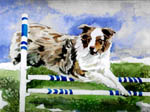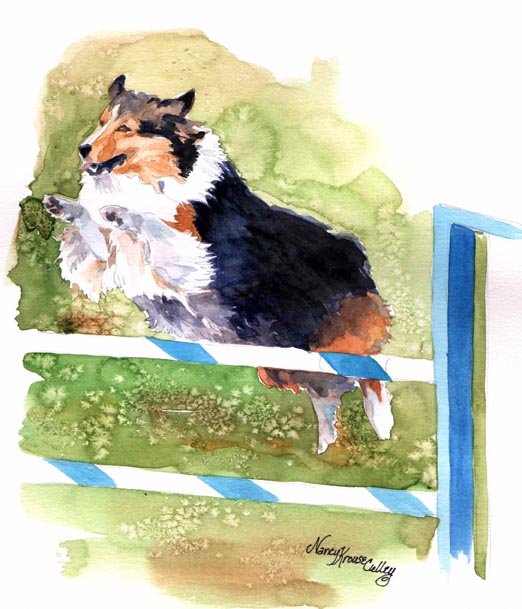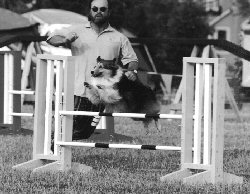95% of the time it's handling error
 How
would you like to have perfect timing? That is, to never again be early or late with a command
or movement? Itís a simple matter once you understand that every movement and every command has
a specific cue. All the handler needs to do is understand his cues and be disciplined enough to
use them. How early should you turn your dog over a jump? How late? American agility guru Bud
Houston applies the physics of Laws of Dogs in Motion© to
a practical problem in this article, abridged from Clean Run . How
would you like to have perfect timing? That is, to never again be early or late with a command
or movement? Itís a simple matter once you understand that every movement and every command has
a specific cue. All the handler needs to do is understand his cues and be disciplined enough to
use them. How early should you turn your dog over a jump? How late? American agility guru Bud
Houston applies the physics of Laws of Dogs in Motion© to
a practical problem in this article, abridged from Clean Run .
Timing is dictated by position and event. You first have to get out of your
head that 'timing' in agility has anything to do with time whatsoever. Itís all a matter of
where things are positioned in space: you, the dog, and the obstacle. Thinking in terms of time
creates the illusion that the handler must rush a movement with a fast dog or that the handler
of a slower dog can afford to be leisurely.
Iíve made no attempt in this discussion to expound on obvious rules of
timing but they warrant a mention:
- Give the command for an obstacle at the moment the
dogís nose is pointed at it - not earlier, and not later.
- Allow the dog to finish his work on contact obstacles,
weave poles, and jumps before turning in a new course direction.
- Work on the same obstacle on which the dog is working.
Timing of verbal commands
Most people think of timing as a matter of when to give a verbal command. In
fact, the timing of verbal commands is the least important requisite for perfect timing in
agility, and one for which the handler can observe a simple rule. Weíve all seen that handler
whose timing of verbal commands is so poor that he commands Jump while the dog is in the air
over the jump for which the command is given. Obviously, the dog had already figured out that
the jump was the correct obstacle. We have also seen the handler who commands Jump when the dog
is facing the wrong jump. The dog is absolutely correct to take the jump when the handler has
given the command to do so.
A handler should issue a command for
obstacle performance at the moment that the dog is facing the correct obstacle. Consequently,
the handler should focus on his real job, which is to get the dog facing the next correct
obstacle. And then, at the earliest possible moment, the handler should give the command. Since
dogs move faster than humans, itís not a bad idea to give the dog the
mission for the next obstacle even while at a considerable distance.
 Timing
of movements Timing
of movements
Any understanding of timing must start with understanding how a dog moves.
Therefore, the handler must acknowledge and understand the Laws of Dogs in Motion:
The Laws of Dogs in
Motion©
-
The dog turns when the handler turns
-
The dog tends to work in a path
parallel to the handlerís path
-
The dog gets his speed cue from the
handlerís speed
-
The dog gets his direction cue from the
handlerís shoulders, toes, hips, and movement
-
A dog ahead of the handler tends to curl back to the
handlerís position
The first law is
really the most important: the dog turns when the handler turns. This isnít anything tricky or
mystical. The dog wants to go in the same direction his handler is going so, naturally, the dog
will turn when the handler turns. When the bar drops, 95% of the time it is a handling
error.
There really is no one right answer for
all dogs. As soon as some concept convinces me that this is the way to deal with that, along
comes another dog that defies convention and statistical measurement. Each handler needs to
understand his own dogís timing needs.
Without recognizing the positional cues
that dictate matters of timing, the handler has no chance at perfecting his timing. Practicing
movement under the orchestration of cues will help build the necessary muscle memory to make
timing natural and fluid. Working from cues is a discipline. It is not enough to know the cues.
The handler must abide by them.
To read the unabridged article complete with diagrams
and explanations of moves,
see the November 2003 issue of Clean Run.
 About
the author... About
the author...
Bud Houston operates Dogwood Training Center in central Ohio, location of
Camp Dogwood, which runs 14 training camps a year. Besides teaching his own classes and camps,
Bud teaches about 20 agility handling seminars a year throughout the USA.
Bud is a columnist for Off-Lead
Magazine as well as the author of 20 volumes of training manuals published in the pages of
the Just For Fun Agility Notebook. He also wrote the very popular series of Agility
Workbooks published by Clean Run Productions. Bud has also co-authored a number of books:
-
Go The Distance, a training
manual aimed at teaching handlers to work at a distance from their dogs with Stacy
Peardot-Goudy
-
The Clean Run Book of Agility
Games, a comprehensive guide to rules for agility games with Stuart Mah
-
The Junior Handlersí Training
Manual with Ruth Van Keuren
-
His latest book, The Clean Run
Book of Agility Games, 2nd edition, was released in 2003.
You can visit his
website http://www.dogwoodagility.com
Reprinted with kind permission of Clean Run (November 2003)
Sketch of Bud Houston by
Nancy Krause Culley from
http://oursheltiesite.freeservers.com/agilityadventures/agilityadventures_budsgames.html
|